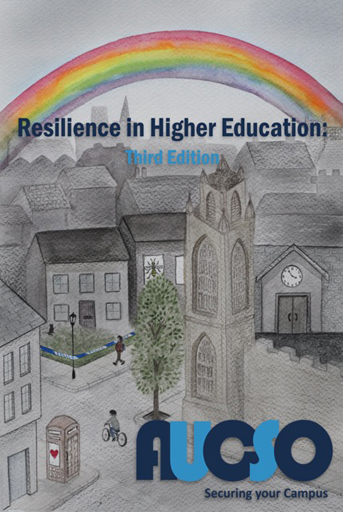The third edition of the guidance document, Resilience in Higher Education, was aired at the annual Aucso conference of university security chiefs of security, at Aston, last week, by lead reviewer and author, Dr Lucy Easthope LLB MSc FEPS FHEA FRAI, Director of Whatever Next Productions Ltd. Mark Rowe digests the guide, now available to Aucso members as a download from the association website.
As Prof Dame Janet Beer put it in a foreword to the 217-page document: “Universities are increasingly complex and operational activity is interlinked. It is crucial for all university staff to see resilience as a part of their own role and for all departments, through their planning, to offer the kind of mutual aid and support that would be required during incidents that cause significant This includes planning for disruption to their own areas of responsibility and understanding any fragility at the boundaries they share with other departments.”
Dame Janet, as President of Universities UK, was an opening speaker at the Aucso conference, itself a sign of the higher education sector’s regard for Aucso and of the appreciated importance of security to a safe and thriving campus.
As Dr Lucy Easthope pointed out in her good-natured and well-received talk to the gathering in Birmingham, the cover may at first look typically or even sentimentally English – a church tower, a red telephone box, town rooftops beneath a rainbow. Look again however and you see blue police tape to cordon off an incident. As that scene implies, an incident does not have to happen at a campus for it to affect students; the Grenfell Tower fire of July 2017 in west London affected students as mentioned both by Lucy Easthope and Dame Janet. Likewise the May 2017 Manchester terror attack, covered in the guidance.
While as Lucy Easthope outlined to the conference, there are two new chapters, on housing and ’emerging concerns’, like many things in life that reach a third edition, much has changed but much stays the same. The risks remain natural and acts of God as well as man-made; fires, floods and stormy weather (as hit Aberystwyth University buildings, in 2014). Extreme weather is one of the case studies.
The document takes you through risk, planning, and emergency management. The guidance like Lucy’s talk takes you ‘post-incident’ besides the hours of emergency response ‘when the call comes in’. The weeks and months after of ‘business continuity’ may not feel as urgent, or as necessary to run an exercise about beforehand, but issues need addressing. To return to housing. How might disruption affect their studies, or exams if at exam time? What of ’emotional resilience’, student welfare, in a word, a task increasingly dropping onto the plate of security managers and departments who once were merely in charge of bundles of keys, and maybe car parking.
To touch on how comprehensive the document is; it points to the positives of social media for crisis communications. Another pressing issue for security managers in any sector is lone workers and traveller safety. The guide covers this. To take a hypothetical example; what of a PhD student in botany? What could be risky about that? Risky if the student goes into the jungle in central America and gets caught up in a military coup or a kidnapping. Has the followed the Foreign Office advice for that country – did the student even read it?! Does the supervising academic and home institution know the whereabouts of their student, let alone know what to do or advise?
In short, as the document says and as Lucy set out, planners and those testing their preparations must make sure they test what’s ‘difficult’. And Lucy in her talk took on the excuses for not testing and taking resilience planning seriously – such as, you’re always planning for the last war and the previous incident type, and yet the next one will be different. In truth, fires and storms – causing homeless students without electricity – keep happening. And the front of the new edition includes a testimonial (unsolicited) from New Zealand to praise the first, 2008 edition of the guide, as a help after the 2011 Christchurch earthquake.
Not for the first time – its international exchanges for members to the United States and now Australia being another example – the thorough and authoritative and well marshalled guide shows Aucso as the security sector body that sets the standard for others.









